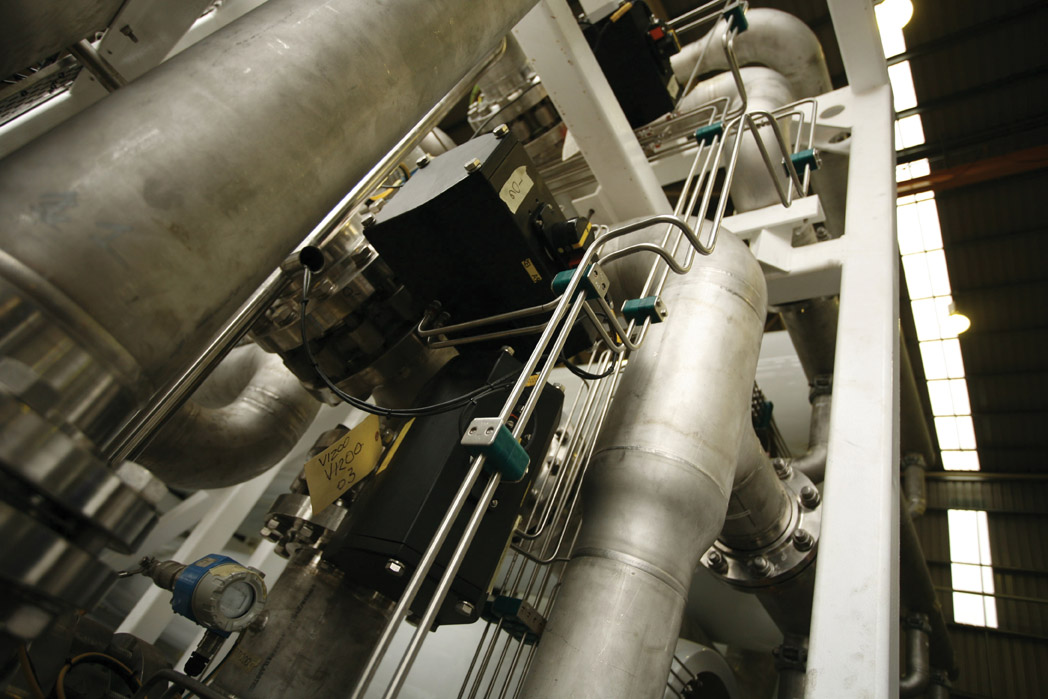
Never has there been a time in Australia when water preservation was so critical. As populations rise and dam levels fall, the importance of treating and reusing water has become not a question of “if” but a question of “when”.
 The construction of Bundamba Advanced Water Treatment Plant (BAWTP) west of Brisbane is aimed at alleviating pressure on South East Queensland’s existing dams and waterways by providing an alternate water supply for end users in the region, initially Swanbank power station.
The construction of Bundamba Advanced Water Treatment Plant (BAWTP) west of Brisbane is aimed at alleviating pressure on South East Queensland’s existing dams and waterways by providing an alternate water supply for end users in the region, initially Swanbank power station.
The project has had great flow on benefits for the Australian stainless steel industry as infrastructure requirements point to the material for its strength, corrosion resistance and application performance.
The world-class BAWTP is a joint venture between Thiess Pty Ltd and Black & Veatch, who are responsible for the engineering, design, procurement and construction. Management of the project is in alliance with the Queensland Government. A number of ASSDA members were sub-contracted by Thiess Pty Ltd for various stages of the project, including ASSDA Accredited Fabricator D&R Stainless, Perfab Engineering and Stainless Pipe and Fittings Australia.
Following a tender process, D&R Stainless was engaged for off-site pipe spooling. The quantity of stainless steel used for the job, including around 3000 flanges, meant that D&R Stainless was issued with the materials by Thiess Pty Ltd as needed.
Many of the piping materials for the first two stages of the project were supplied to Thiess Pty Ltd by Stainless Pipe and Fittings. Materials were in excess of 350 tonnes and included pipe, pipe fittings and flanges in grade 316L with sizes ranging from 25-600nb.
 Once delivered, D&R Stainless cut and bevelled the pipe and then welded and passivated internally and externally before undergoing hydro testing.
Once delivered, D&R Stainless cut and bevelled the pipe and then welded and passivated internally and externally before undergoing hydro testing.
D&R Stainless Director Karl Manders said that, not only did the pipes use grade 316, but they were also fabricated to Australian Standard 4041, class 1.
“Because the pipework adhered to such a high standard, 10% of all welds were x-rayed for quality,” he says. Passivation of the pipe welds involved applying pickling paste inside and out, and then scrubbing and flushing to avoid loose scale, important for the fine filtration of the water treatment plant.
Karl says quality was something Thiess Pty Ltd took very seriously, with a welding inspector and quality checker appointed at their premises.
“This was to ensure all welding and passivation was performed at the highest standard, and also to ensure that production off-site was consistent with installation schedules onsite”.
Perfab Engineering was also sub-contracted by Thiess Pty Ltd for the manufacture of the reverse osmosis (RO) skids at its workshops in Newcastle, working closely with the designers from suppliers Koch Membrane Systems in the United States.
The work carried out by Perfab included fabrication and surface treatment of the carbon steel skid frames, fabrication of the stainless steel pipework, full mechanical installation of the valves, instrumentation and RO pressure vessels, pneumatic fitout, electric fitout and testing.
The high pressure pipe spools were fabricated from Sch 40S pipe with 300# flanges and low pressure pipe spools from Sch 10S pipe with 150# flanges.
Perfab has three orbital Gas Tungsten Arc Welding (or TIG) machines that were operated around the clock to ensure the tight delivery times were achieved, however Perfab Engineering General Manager Damien Ryba says “the biggest contributor to the success of the job was having a well trained, highly skilled and productive workforce committed to the success of the project”.
At present, the BAWTP 1A is in full operation and delivering water to the Swanbank Power Station. Thiess Black and Veatch Director, Gus Atmeh, said that the BAWTP 1A project was delivered ahead of schedule and this was due to the support of the project by high quality stainless steel fabrication shops from across Australia and particularly from South East Queensland, who provided stainless steel components for state of the art process equipment and piping: “Without them we could not have made it on time.”
This article featured in Australian Stainless Issue 41